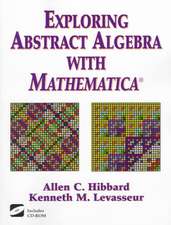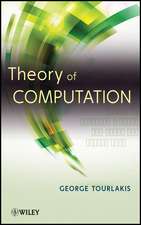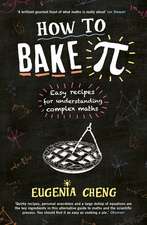Game of Life Cellular Automata
Editat de Andrew Adamatzkyen Limba Engleză Paperback – 4 noi 2014
| Toate formatele și edițiile | Preț | Express |
|---|---|---|
| Paperback (1) | 1002.02 lei 6-8 săpt. | |
| SPRINGER LONDON – 4 noi 2014 | 1002.02 lei 6-8 săpt. | |
| Hardback (1) | 1008.62 lei 6-8 săpt. | |
| SPRINGER LONDON – 5 iul 2010 | 1008.62 lei 6-8 săpt. |
Preț: 1002.02 lei
Preț vechi: 1252.51 lei
-20% Nou
Puncte Express: 1503
Preț estimativ în valută:
191.76€ • 199.46$ • 158.31£
191.76€ • 199.46$ • 158.31£
Carte tipărită la comandă
Livrare economică 14-28 aprilie
Preluare comenzi: 021 569.72.76
Specificații
ISBN-13: 9781447161547
ISBN-10: 1447161548
Pagini: 600
Ilustrații: XIX, 579 p.
Dimensiuni: 155 x 235 x 32 mm
Greutate: 0.83 kg
Ediția:2010
Editura: SPRINGER LONDON
Colecția Springer
Locul publicării:London, United Kingdom
ISBN-10: 1447161548
Pagini: 600
Ilustrații: XIX, 579 p.
Dimensiuni: 155 x 235 x 32 mm
Greutate: 0.83 kg
Ediția:2010
Editura: SPRINGER LONDON
Colecția Springer
Locul publicării:London, United Kingdom
Public țintă
ResearchCuprins
to Cellular Automata and Conway’s Game of Life.- Historical.- Conway’s Game of Life: Early Personal Recollections.- Conway’s Life.- Life’s Still Lifes.- A Zoo of Life Forms.- Classical topics.- Growth and Decay in Life-Like Cellular Automata.- The B36/S125 “2x2” Life-Like Cellular Automaton.- Object Synthesis in Conway’s Game of Life and Other Cellular Automata.- Gliders and Glider Guns Discovery in Cellular Automata.- Constraint Programming to Solve Maximal Density Still Life.- Asynchronous, Continuous and Memory-Enriched Automata.- Larger than Life’s Extremes: Rigorous Results for Simplified Rules and Speculation on the Phase Boundaries.- RealLife.- Variations on the Game of Life.- Does Life Resist Asynchrony?.- LIFE with Short-Term Memory.- Localization Dynamics in a Binary Two-Dimensional Cellular Automaton: The Diffusion Rule.- Non-Orthogonal Lattices.- The Game of Life in Non-square Environments.- The Game of Life Rules on Penrose Tilings: Still Life and Oscillators.- A Spherical XOR Gate Implemented in the Game of Life.- Complexity.- Emergent Complexity in Conway’s Game of Life.- Macroscopic Spatial Complexity of the Game of Life Cellular Automaton: A Simple Data Analysis.- Physics.- The Enlightened Game of Life.- Towards a Quantum Game of Life.- Music.- Game of Life Music.- Computation.- Universal Computation and Construction in GoL Cellular Automata.- A Simple Universal Turing Machine for the Game of Life Turing Machine.- Computation with Competing Patterns in Life-Like Automaton.
Recenzii
From the reviews:
“This volume’s 27 papers offer some systematic methods and rigorous theorems that exhibit the study of Conway’s game and its variations, emerging out of the realm of merely recreational mathematics. … this unique book will have great value as both a state-of-the-art summary and a collection of proposals for new directions to explore. Summing Up: Highly recommended. Upper-division undergraduates through professionals.” (D. V. Feldman, Choice, Vol. 48 (4), December, 2010)
“Andrew Adamatzky has assembled a superb collection of papers on Life that encompass work going back more than 20 years. … maintains a good balance between interconnectedness and recognition of the papers as independent contributions. … This book is a treasure trove of history, concepts, and models. It is a good starting place for a newcomer to the study of Conway’s Game of Life, an opening of vistas for the amateur hobbyist, and a serious handbook for the professional researcher.” (Anthony J. Duben, ACM Computing Reviews, February, 2011)
“This volume’s 27 papers offer some systematic methods and rigorous theorems that exhibit the study of Conway’s game and its variations, emerging out of the realm of merely recreational mathematics. … this unique book will have great value as both a state-of-the-art summary and a collection of proposals for new directions to explore. Summing Up: Highly recommended. Upper-division undergraduates through professionals.” (D. V. Feldman, Choice, Vol. 48 (4), December, 2010)
“Andrew Adamatzky has assembled a superb collection of papers on Life that encompass work going back more than 20 years. … maintains a good balance between interconnectedness and recognition of the papers as independent contributions. … This book is a treasure trove of history, concepts, and models. It is a good starting place for a newcomer to the study of Conway’s Game of Life, an opening of vistas for the amateur hobbyist, and a serious handbook for the professional researcher.” (Anthony J. Duben, ACM Computing Reviews, February, 2011)
Notă biografică
Andrew Adamatzky is a Professor in Unconventional Computing in the Department of Computer Science, and a member of Bristol Robotics Lab. He does research in reaction-diffusion computing, cellular automata, physarum computing, massive parallel computation, applied mathematics, collective intelligence and robotics.
Textul de pe ultima copertă
In the late 1960s British mathematician John Conway invented a virtual mathematical machine that operates on a two-dimensional array of square cell. Each cell takes two states, live and dead. The cells’ states are updated simultaneously and in discrete time. A dead cell comes to life if it has exactly three live neighbours. A live cell remains alive if two or three of its neighbours are alive, otherwise the cell dies. The Conway’s Game of Life became the most programmed solitary game and the most known cellular automaton. The book brings together results of forty years of study into computational, mathematical, physical and engineering aspects of the Game of Life cellular automata. Selected topics include phenomenology and statistical behaviour; space-time dynamics on Penrose tilling and hyperbolic spaces; generation of music; algebraic properties; modelling of financial markets; semi-quantum extensions; predicting emergence; dual-graph based analysis; fuzzy, limit behaviour and threshold scaling; evolving cell-state transition rules; localization dynamics in quasi-chemical analogues of GoL; self-organisation towards criticality; asynochrous implementations.The volume is unique because it gives a comprehensive presentation of the theoretical and experimental foundations, cutting-edge computation techniques and mathematical analysis of the fabulously complex, self-organized and emergent phenomena defined by incredibly simple rules.
Caracteristici
Simple to understand examples of cellular automata dynamics Abundance of illustrations, working examples, and codes Efficient techniques for evaluating space-time dynamics of discrete non-linear systems References to online interacting demonstrations Overview of exciting concepts at the edge of mathematics, computer science, engineering and physics Includes supplementary material: sn.pub/extras











